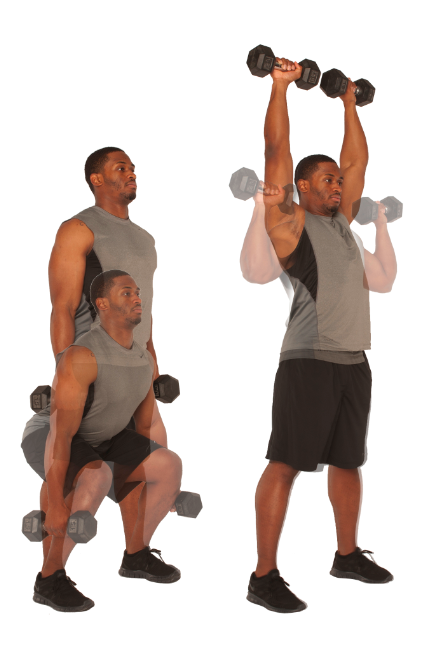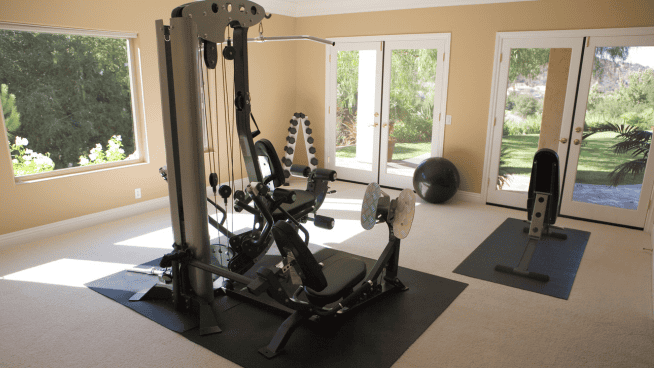Dumbbell Squat and Press 101: A How-To Guide
The Dumbbell Squat and Press is a foundational exercise for any athlete who wants to build strength and power in the legs and hips, particularly in the quads and glutes. This variation of the Dumbbell Squat adds a shoulder press, which also increases upper-body strength and core stability. Through this guide, you’ll learn how to perform the Dumbbell Squat and Press to take your workouts to the next level. Finally, check out some of STACK’s Dumbbell Squat and Press workout videos, featuring elite athletes like Brandon Roy and Jimmy Rollins, to learn how to adapt the Dumbbell Squat and Press for your sport.
Dumbbell Squat and Press How-To
- Assume athletic stance with feet slightly wider than hip width, holding dumbbells at shoulders with palms facing together
- Keeping back straight and knees behind toes, sink hips back and lower into squat position until thighs are parallel to ground
- Extend hips and knees to drive up out of squat position and press dumbbells overhead
- Lower dumbbells to shoulders; repeat for specified reps
Getting Started
Beginners should focus on perfecting form and technique before adding resistance. Perform Bodyweight Squats or Wall Squats. To perfect the movement, work through the Dumbbell Squat and Press with no weight in front of a coach.
Advanced Dumbbell Squat Presses
For an additional challenge, advanced athletes can increase their Squat depth, perform single-leg variations or focus on driving explosively out of the Squat. Or, perform the Dumbbell Squat Press on an unstable surface like an inverted Bosu ball to improve balance and stability.
Common Dumbbell Squat and Press Mistakes and Solutions
- Knees Collapse Inward: Reduce the weight of the dumbbells for subsequent sets. Also, perform Bodyweight Squats with a mini band wrapped around thighs just above knees to strengthen the muscles that maintain alignment of the knees with the hips and ankles.
- Knees Travel Beyond Toes: Reduce the weight of the dumbbells for subsequent sets. Focus on sitting your hips back and keeping your chest up.
- Leaning Forward: Places excessive strain on the lower back. If you find yourself leaning, focus on sitting your hips back and keeping your chest up. Perform Bodyweight Squats to improve mobility.
- Rounded Back: Reduce the weight of the dumbbells for subsequent sets. Strengthen the core with exercises like Hypers and Planks before adding additional resistance to your Squat.
- Back Arches During Press: Reduce the weight of the dumbbells for subsequent sets. This is likely caused by a lack of upper-body and core strength, forcing your body to compensate. However, it could also be caused by lack of upper-body mobility, which can be cured with a flexibility and foam rolling routine.
Dumbbell Squat and Press Technique Variations
To continue making strength and size gains, it’s important to vary your exercise selection. Learn how to Squat and find a full list of Squat variations in Squat 101: A How-To Guide.
RECOMMENDED FOR YOU
Dumbbell Squat and Press 101: A How-To Guide
The Dumbbell Squat and Press is a foundational exercise for any athlete who wants to build strength and power in the legs and hips, particularly in the quads and glutes. This variation of the Dumbbell Squat adds a shoulder press, which also increases upper-body strength and core stability. Through this guide, you’ll learn how to perform the Dumbbell Squat and Press to take your workouts to the next level. Finally, check out some of STACK’s Dumbbell Squat and Press workout videos, featuring elite athletes like Brandon Roy and Jimmy Rollins, to learn how to adapt the Dumbbell Squat and Press for your sport.
Dumbbell Squat and Press How-To
- Assume athletic stance with feet slightly wider than hip width, holding dumbbells at shoulders with palms facing together
- Keeping back straight and knees behind toes, sink hips back and lower into squat position until thighs are parallel to ground
- Extend hips and knees to drive up out of squat position and press dumbbells overhead
- Lower dumbbells to shoulders; repeat for specified reps
Getting Started
Beginners should focus on perfecting form and technique before adding resistance. Perform Bodyweight Squats or Wall Squats. To perfect the movement, work through the Dumbbell Squat and Press with no weight in front of a coach.
Advanced Dumbbell Squat Presses
For an additional challenge, advanced athletes can increase their Squat depth, perform single-leg variations or focus on driving explosively out of the Squat. Or, perform the Dumbbell Squat Press on an unstable surface like an inverted Bosu ball to improve balance and stability.
Common Dumbbell Squat and Press Mistakes and Solutions
- Knees Collapse Inward: Reduce the weight of the dumbbells for subsequent sets. Also, perform Bodyweight Squats with a mini band wrapped around thighs just above knees to strengthen the muscles that maintain alignment of the knees with the hips and ankles.
- Knees Travel Beyond Toes: Reduce the weight of the dumbbells for subsequent sets. Focus on sitting your hips back and keeping your chest up.
- Leaning Forward: Places excessive strain on the lower back. If you find yourself leaning, focus on sitting your hips back and keeping your chest up. Perform Bodyweight Squats to improve mobility.
- Rounded Back: Reduce the weight of the dumbbells for subsequent sets. Strengthen the core with exercises like Hypers and Planks before adding additional resistance to your Squat.
- Back Arches During Press: Reduce the weight of the dumbbells for subsequent sets. This is likely caused by a lack of upper-body and core strength, forcing your body to compensate. However, it could also be caused by lack of upper-body mobility, which can be cured with a flexibility and foam rolling routine.
Dumbbell Squat and Press Technique Variations
To continue making strength and size gains, it’s important to vary your exercise selection. Learn how to Squat and find a full list of Squat variations in Squat 101: A How-To Guide.











